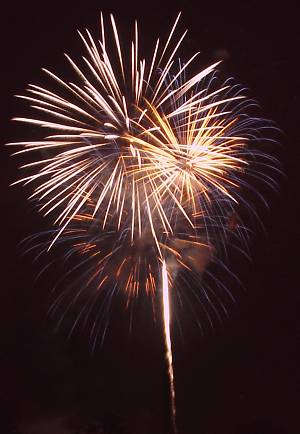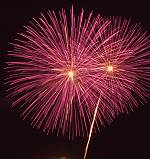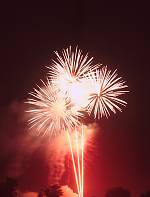July 4th fireworks tips!
By
Mike Tomkins
(Wednesday, July 4, 2001 - 13:21 EDT)

Click for a bigger picture!
With our American readers celebrating Independence Day today, we felt it might be useful to pull out an old news item from our files... Doubtless thousands of digital photographers around the country will today be taking pictures at local fireworks displays, and there's an opportunity for some *great* pictures - if you know what to do.
Last July 4th, we gave you some hints for how to get good results with fireworks photos; read on to find out what to do!
 Originally published July 3rd 2000: Once again, July 4th is with us, and many American readers will no doubt be anticipating their local fireworks displays, a sight that always seems to fill us with awe - and is a great subject for photos, if you know what to do! Originally published July 3rd 2000: Once again, July 4th is with us, and many American readers will no doubt be anticipating their local fireworks displays, a sight that always seems to fill us with awe - and is a great subject for photos, if you know what to do!
Digital cameras can really come into their own for fireworks photography, as Mike found out at a fireworks display in the Amana Colonies, Iowa last August (the three photos accompanying this article are just a sample of those I shot that night - click on each for a larger version)...
Whilst an attempt to really give you a handle on fireworks photography would take quite some space, and is outside the remit of this news page, we can certainly give you a few tips that worked for us in the past...- Choose your location carefully... As Dave found out last July 4th, whilst the fireworks might be spectacular to watch up close, for interesting photos you're better off shooting the 'works from a bit of a distance, so that you're getting a "side view" rather than looking up at everything.
- This might sound obvious, but don't underestimate the importance of a good tripod. One of the most common problems we've experienced with fireworks photography in the past has been that our tripod wasn't sturdy enough, or that we tried to handhold the photo or balance our camera on a car roof as we weren't expecting the display and were caught without a tripod. Whilst you'd be surprised what you can handhold with some digital cameras, a sturdy tripod will always give you the best results...
- If your camera has a remote shutter release, use it! Even tripod mounted, you're likely going to shake the camera a little when you press the shutter button - a cabled shutter release or better still an infra-red one will eliminate this possibility.
- Make sure your camera is set up right before you get to the show! It is always so easy to forget a setting change you made, and get back home to find that your photos aren't quite what they could have been because the last time you used the camera, you increased the compression or something equally trivial. Make sure you confirm the camera setup ahead of time, and even try experimenting with your camera before the show starts to get an idea of what setup you might need...
- Make sure all of your flash cards are blank, and all of your batteries are charged - better safe than sorry! If your camera doesn't take rechargeables, be sure you have plenty of new batteries to hand!
- Remember that fireworks are actually pretty bright! You'll want to expose for the highlights, as that is what's important in fireworks, and if you over-expose, you'll lose the colors and detail of the 'works. This could be tricky depending on what control your camera offers...
- Try and give yourself some leeway in the length of your photos - a longer photo has more chance of catching a firework from start to finish, and giving impressive "streamers" rather than little specks of light. Don't over-do it though, too many fireworks in one shot can be a bad thing, making it impossible to see anything...
- If your camera offers variable ISO ratings, a lower ISO will help with both of the above points... If possible, so will smaller apertures (and they'll also help depth of field, too!) In a snip, use a neutral density filter if you can fit one to the camera... I've even seen a pair of sunglasses attached to a camera before, and although this is bound to affect color and picture quality, it still might be better than no photos at all!
- Be sure to bracket your exposures somewhat. Even though the subject is continually changing, varying your exposure (best accomplished, if possible, by varying your aperture slightly) will help ensure that you get plenty of correctly exposed photos. If you guess wrong and take all of your photos with the same settings, you might get home and find they're all disappointing...
- Most of all, remember digital's big advantage here - if the photo doesn't work, you can just delete it. Take as many photos as you can (without letting the camera-work detract from your enjoyment of the display, of course) - you can delete the bad ones later. The more photos you take, the better your chances of some really stunning shots! Intermissions in the fireworks display, if there are any, are a great time to shoot through your photos and free up some space by deleting anything that didn't turn out great...
- To give an idea of what you might expect, my photos accompanying this article were shot with a Sony Cyber-shot Pro DSC-D770 camera in fully manual mode, using an ISO rating of 50, a shutter speed of 4 seconds (the maximum the D770 can manage), and various apertures from about F8 to F9.5. The camera was manually prefocused, tripod mounted, and several hundred shots were triggered using the infra-red shutter release. The camera was in its highest size and quality modes, had two fully charged batteries, and the 128MB ATA PC card and 8MB MemoryStick were both filled up more than once before the end of the show!
 Most of all, be sure and have fun! Don't spend the entire evening with your eyes glued to the camera - enjoy the fireworks in person, and take plenty of photos so you can relive the experience at home too! Here's a few links to help you out and inspire you, courtesy of Steve's Digicams, Rob Galbraith Online and our own coverage from last year: Most of all, be sure and have fun! Don't spend the entire evening with your eyes glued to the camera - enjoy the fireworks in person, and take plenty of photos so you can relive the experience at home too! Here's a few links to help you out and inspire you, courtesy of Steve's Digicams, Rob Galbraith Online and our own coverage from last year:
Images copyright (c) 1999, 2000, 2001 Michael R. Tomkins. All rights reserved
|